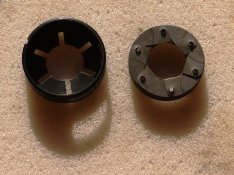David Lyga
Member
I have a tip that I learned some time ago that might be of help to those experiencing this 'focus-shift' problem with his/her zoom lens.
When you carefully focus at the widest setting, then switch to the tele setting, does your focus shift slightly? (Or even more than slightly?)
I have found that the distance that that rear element-set is from the film plane is the determining factor in rectifying this malady. On zooms, the rear element-set usually has two circular threaded-nuts for which there are two different functions. The INNER one guides the element set into the lens body. That is common sense and is found on almost every lens, zoom or fixed focal length. The OUTER one guides how far that rear element-set is supposed to go into that lens body. In other words, on zooms, the rear element-set is not supposed to go all the way into the lens body; the amount it is screwed in determines how accurately the tele focus and wide focus will match (as they should on zooms, rather than on varifocal lenses).
Here is the rule of thumb that seems to work for me. First, focus as accurately as you can at the wide setting. Choose something very bright and well defined so that you can be ACCURATE. Then, without moving that focus even a bit (tape the focus in place in order to secure it), zoom to the full tele position. IF, AT THAT POINT, YOU HAVE TO MOVE THE FOCUS RING TOWARDS INFINITY IN ORDER TO BE IN PERFECT FOCUS, THE REAR ELEMENT-SET MUST BE POSITIONED A BIT MORE INWARD (TOWARD THE APERTURE) IN ORDER TO CORRECT THIS. (Of course, the opposite is true if you need to go the other way, but I won't repeat what is obvious.)
By trial and error, mounting and remounting the lens and carefully focusing upon the same spot, you will find the exact position that that rear element set must be positioned and all this should use no film and take about twenty minutes of time.
Honestly, there might be some lenses which adhere to a different way of doing this, but I have found that most will adhere to what I have just explained. - David Lyga
When you carefully focus at the widest setting, then switch to the tele setting, does your focus shift slightly? (Or even more than slightly?)
I have found that the distance that that rear element-set is from the film plane is the determining factor in rectifying this malady. On zooms, the rear element-set usually has two circular threaded-nuts for which there are two different functions. The INNER one guides the element set into the lens body. That is common sense and is found on almost every lens, zoom or fixed focal length. The OUTER one guides how far that rear element-set is supposed to go into that lens body. In other words, on zooms, the rear element-set is not supposed to go all the way into the lens body; the amount it is screwed in determines how accurately the tele focus and wide focus will match (as they should on zooms, rather than on varifocal lenses).
Here is the rule of thumb that seems to work for me. First, focus as accurately as you can at the wide setting. Choose something very bright and well defined so that you can be ACCURATE. Then, without moving that focus even a bit (tape the focus in place in order to secure it), zoom to the full tele position. IF, AT THAT POINT, YOU HAVE TO MOVE THE FOCUS RING TOWARDS INFINITY IN ORDER TO BE IN PERFECT FOCUS, THE REAR ELEMENT-SET MUST BE POSITIONED A BIT MORE INWARD (TOWARD THE APERTURE) IN ORDER TO CORRECT THIS. (Of course, the opposite is true if you need to go the other way, but I won't repeat what is obvious.)
By trial and error, mounting and remounting the lens and carefully focusing upon the same spot, you will find the exact position that that rear element set must be positioned and all this should use no film and take about twenty minutes of time.
Honestly, there might be some lenses which adhere to a different way of doing this, but I have found that most will adhere to what I have just explained. - David Lyga
Last edited:



